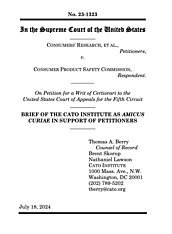Consumers’ Research and By Two are both organizations that conduct research on consumer products. As part of their work, they regularly submit Freedom of Information Act (FOIA) requests to the Consumer Product Safety Commission (CPSC), an agency that Congress created in 1972 to regulate a vast number of consumer products and to enforce its mandates with financial penalties.
After the CPSC denied a set of the organizations’ FOIA requests in 2021, the organizations sued the agency. They argued that the CPSC Commissioners’ removal protections were unconstitutional and that the FOIA procedures the Commission enforced were therefore invalid. But the Fifth Circuit disagreed, holding that the CPSC’s structure is constitutional and rejecting the organizations’ claims. Now the organizations are seeking review from the Supreme Court, and Cato has filed an amicus brief in support of their petition.
Our brief explains that the Constitution “vest[s]” in the President all the “executive Power” and gives him the duty to “take Care that the Laws be faithfully executed.” For the President to fulfill his constitutional responsibilities, he generally must have the authority to remove his principal subordinates.
The Supreme Court has recognized only two exceptions to the presidential removal power. The exception relevant to this case stems from the 1935 case Humphrey’s Executor v. United States, which upheld for-cause removal protections for FTC Commissioners on the ground that the Commissioners “occup[y] no place in the executive department and … exercise[] no part of the executive power.”
But as our brief points out, Humphrey’s Executor rests on shaky footing. The Supreme Court has since acknowledged that the FTC in 1935 did in fact exercise executive power. And in Seila Law LLC v. CFPB (2020), the Court struck down removal protections for an agency director who possessed substantial executive power. The Seila Law Court clarified that the Humphrey’s Executor exception is limited to agencies acting as a “mere legislative or judicial aid.” The Supreme Court has effectively repudiated almost every aspect of Humphrey’s Executor, but it has not yet overruled the case.
Because Humphrey’s Executor has not yet been explicitly overruled, the Fifth Circuit concluded that its binding precedent “still protects any traditional independent agency headed by a multimember board” like the FTC. And because the CPSC has the same structure as the FTC, the Fifth Circuit deemed the CPSC Commissioners to be covered by Humphrey’s Executor.
Our brief argues that the Fifth Circuit read Seila Law too narrowly, holding that the case only addresses agencies with single directors. Seila Law categorically held that agencies exercising substantial executive power fall outside the Humphrey’s Executor exception, and that important clarification applies just as much to agencies with multiple directors.
As the Fifth Circuit acknowledged, the Supreme Court “has created uncertainty that only it can ultimately alleviate.” This case presents the perfect vehicle for resolving the uncertainty. Even Judge Don Willett, who authored the majority opinion below, said that “this cert petition writes itself.” The Supreme Court should grant the petition and reverse the Fifth Circuit.



